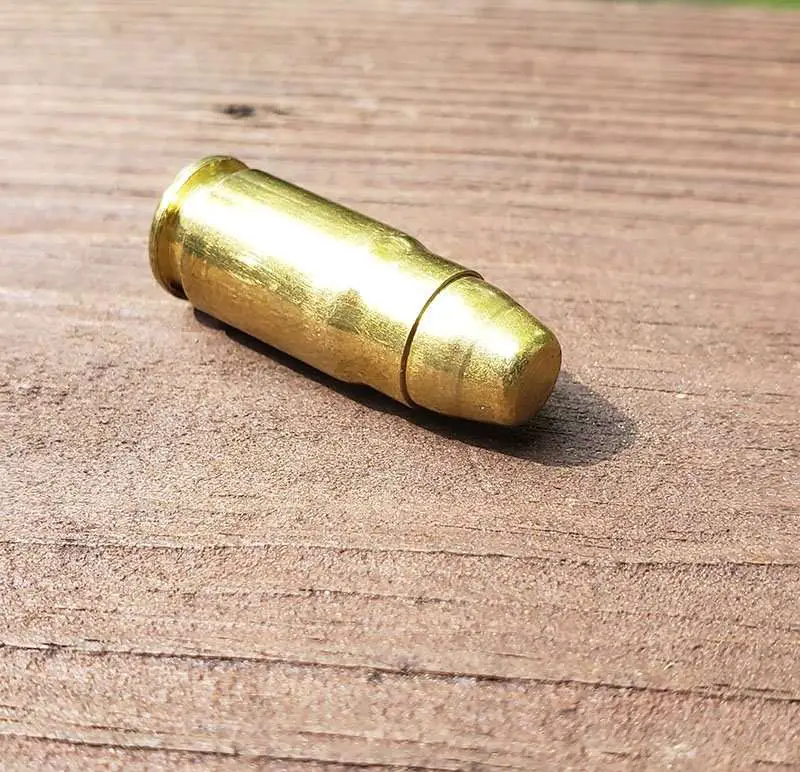357 Sig Ballistics:
A gun with a 4 inch barrel can propel a 125 grain projectile to 1,350 feet per second and 506 LB/FT of energy at the muzzle. At 50 yards, energy drops to 395 LB/FT and 1192 FPS. Then at 100 yards, velocity slows to 1,078 feet per second, and energy drops to 323.
Here is a 357 SIG ballistics chart with the above stats, expanded. This is a Federal Premium 125 grain 357 SIG fired from a 4 inch barrel.
| Velocity (FPS) | Energy (FT/LB) | Drop (Inches) | |
| Muzzle | 1,350 | 506 | / |
| 50 YDS | 1,192 | 395 | -.5 |
| 100 YDS | 1,078 | 323 | -6.1 |
The following ballistics chart assumes a 125 grain Federal HST hollow point. This is a 357 SIG fired from a 4 inch barrel.
| Velocity (FPS) | Energy (FT/LB) | Drop (Inches) | |
| Muzzle | 1,360 | 513 | / |
| 50 YDS | 1,200 | 400 | -.4 |
| 100 YDS | 1,083 | 326 | -6.0 |
The following ballistics chart assumes a 135 grain Hornady Critical Duty Flex Lock fired from a 4 inch barrel
| Velocity (FPS) | Energy (FT/LB) | Drop (Inches) | |
| Muzzle | 1,225 | 450 | -1.5 |
| 50 YDS | 1,125 | 379 | 0 |
| 100 YDS | 1,050 | 330 | -5.4 |
In other words, the 357 SIG is a very potent handgun cartridge capable of delivering some serious energy on target.
To prove my point, let’s compare something —
The 357 SIG and 380 ACP are two totally different cartridges that were never meant to be compared to each other. Yet, I find myself unable to resist. The 357 SIG has more energy at 100 yards than the 380 ACP does at the muzzle.
When people ask what the purpose of the 357 SIG cartridge is, that’s as good of an answer as any.
357 Sig Handgun Cartridge:
The 357 Sig cartridge was designed by Federal and SIG Sauer in a joint venture. It was then introduced to the public in 1994. The sole purpose of this bottle-neck cartridge design was to create a larger case capacity to launch standard 9mm bullets at a higher velocity.
This increased velocity came with the side affect of increased muzzle blast over 9mm, but is overall a more potent round.

SIG and Federal wanted to replicate the performance of the 357 Magnum revolver round, but in a semi-auto platform that was geared toward law enforcement.
While the round has its cult following, it never really gained the wide following it deserved.
The cartridge did not disappoint. They achieved the ballistics they were after, and did it by shortening and necking down a 10mm cartridge to accept a 9mm projectile.
But it had some issues, which prevented it from reaching what it could have been.
357 SIG Issues:
Until this point, I’ve made the 357 SIG out to be a saint. This is the end all cartridge and all others suck, right?
Not so fast.
I’d be remiss not to mention some obvious points about what actually sucks about the 357 SIG pistol cartridge. First and foremost is the cost. The cost of this stuff is effing atrocious. Even before the ammo shortage this ammo was not only harder to find than the other common semi-auto calibers, but about twice as much as 9mm.
I just pulled out a couple of boxes of S&B 140 grain ball ammo (the stuff pictured) that I bought about 4 years ago that had a price tag of $29.99 on it. Today I’m seeing boxes of 50 rounds going for upwards of 70 – 75 bucks for fifty rounds.
Another downside of the 357 SIG is the extra wear it puts on your guns. It tends to wear guns out faster than most other calibers do, and it shouldn’t be surprising. Sometimes those bullets are screaming at close to 1,400 feet per second. That’s nothing to sneeze at, and the internals of guns don’t like it much.
It just wears guns out faster.
Reloading Information:
Bullet Diameter: .355 Inch.
Maximum Case Length: .865 Inch.
Trimmed Case Length: .860 Inch.
Primer Size: Small Pistol.
Maximum Cartridge Overall Length: 1.140 Inches.
Conclusion:
The 357 SIG fills a niche role very well. It produces very impressive ballistics and is a capable cartridge. However, it is expensive and hard to find, especially right now with the ammo shortage we’re currently in.
Though its following is big enough that it’s around to stay for a while longer.
Read next: My comparison of 9mm Luger to 357 Sig.
Also check out our massive handgun ballistics chart.


